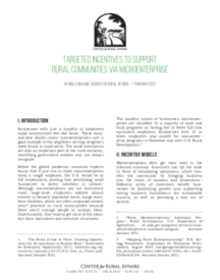Businesses with just a handful of employees make communities feel like home. These mom-and-pop shops—many microenterprises—are a good example of the neighbors-serving-neighbors spirit found in rural areas. The small enterprises are also an important part of the rural economy, something government entities may not always recognize.
Before the global pandemic, economic experts found that if just one in three microenterprises hired a single employee, the U.S. would be at full employment, proving that prioritizing small businesses in policy solutions is critical. Although microenterprises are not exclusively rural, large-scale employers operate almost entirely in densely populated areas. Large workforce facilities, which are often corporate-owned, aren’t practical in rural communities because there aren’t enough people to sustain them. Unfortunately, they tend to get most of the attention from lawmakers and incentive structures.
The smallest subset of businesses, microenterprises are classified by a majority of state and local programs as having five or fewer full-time equivalent employees. Businesses with 10 or fewer employees also qualify for microenterprise programs in Delaware and with U.S. Rural Development.
Lending
Small Towns


